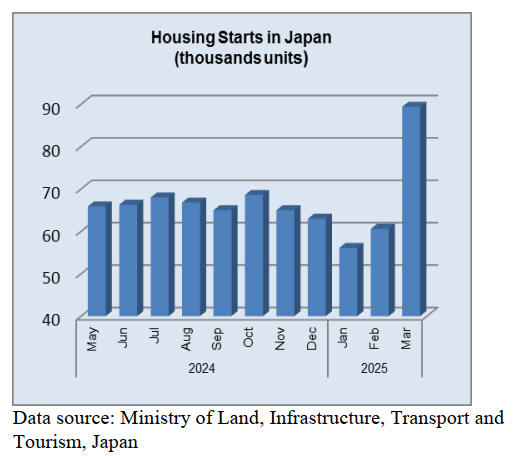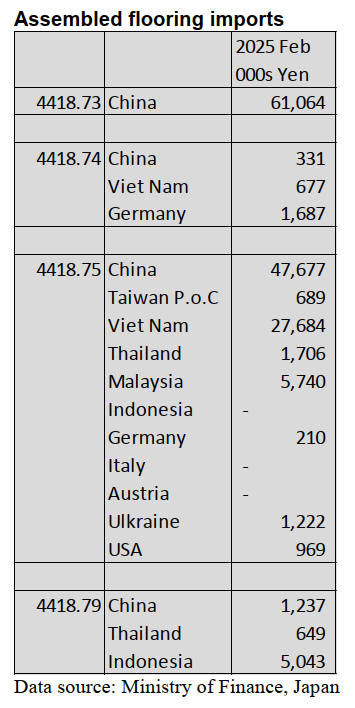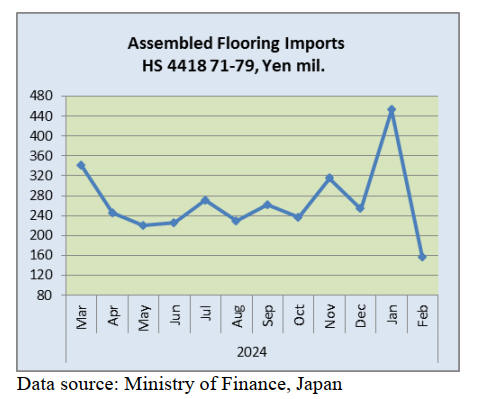Japan
Wood Products Prices
Dollar Exchange Rates of 10th
May
2025
Japan Yen 145.38
Reports From Japan
Weak private consumption and disrupted external
demand up-ends growth
In advance of the official government data most analysts
believe Japan's economy contracted in the first quarter of
2025 due to weak private consumption and disrupted
external demand. Eight out of 11 private-sector research
institutes projected the economy shrank in the first quarter
of this year. If this is the case it would undo three quarters
of growth in 2024.
Three research firms believe private consumption fell due
to higher living costs. Private consumption accounts for
more than half of Japan's GDP. Most researchers say
Japan's GDP was hit by the global economic slowdown.
This reduced earnings from exports at the same time the
cost of imports increased.
On a more positive note, most analysts assess that capital
investment expanded in the first quarter. Analysts point
out GDP was not directly impacted by US tariffs.
If there is actually a decline in GDP this would cast a
shadow over the Bank of Japan’s plans to steadily
continue with policy normalisation. It also highlights
weaknesses in Japan’s economy which could be weakened
further by stringent tariffs in the US.
See: https://www3.nhk.or.jp/nhkworld/en/news/20250512_B2/
Record current account surplus
Japan posted a record current account surplus of US$208
billion in fiscal 2024 marking a high for the second
consecutive year. The success was driven by huge returns
on foreign investments. In the year ended March
government data shows the surplus in the current account
balance, a gauge of international trade, grew 16% year on
year, an all-time high.
The yen averaged 152.48 against the U.S. dollar in
fiscal
2024, 5.5% weaker than the year before with the Japanese
currency's depreciation inflating the value of returns from
foreign investments by domestic companies and overseas
dividend income. Among other key components, imports
climbed 4% and exports rose 4% helped by shipments of
semiconductor-making equipment, electronics parts and
vehicles.
See:
https://mainichi.jp/english/articles/20250512/p2g/00m/0bu/0200
00c
Profits dip – weak sale in US and China
The combined net profit of Japan's manufacturers for the
financial year ended March 31 declined 2% year on year,
the first decline in two years. The downturn was largely
due to automakers which struggled with weak sales in the
US and China. Steelmakers had to contend with cheap
Chinese imports. Automakers' net profit fell by more than
20%.
See:https://asia.nikkei.com/Economy/Japan-manufacturers-log-
1st-profit-decline-in-2-years
Cut in consumption tax discussed as prices surge
Several opposition parties in Japan are arguing for a
consumption tax cut to aid consumers amid soaring prices.
Some are calling for a one-off cut on only food. Others are
suggesting the government make up for any shortfall in tax
revenue that arises from a lower rate by issuing debt. The
ruling Liberal Democratic Party has, so far, resisted calls
for a tax cut and is emphasing its role as the only party that
is able to take responsibility for ensuring the country's
financial stability.
Discussions on the consumption tax have traditionally
been risky for political parties but consumers are facing
mounting price increases and the tax issue is likely to be
the main issue during campaigning for the July Upper
House election.
See: https://japannews.yomiuri.co.jp/editorial/yomiuri-
editorial/20250513-254062/

Yen volatility returns
For a while, because of the turmoil created in the Global
economy, the yen once again became the safe-haven as
money poured in. The US tariff strategy seriously
undermined confidence in dollar assets and early this year
the Japanese yen strengthened by around 10% on the
dollar.
Volatility in currency markets returned as news emerged
that China and the US had reached a tentative initial
agreement driving the dollar higher and the yen lower. In
mid-May the yen was back to around 148 to the US dollar.
See:https://asiatimes.com/2025/05/how-trump-made-
japans-yen-great-again/

Not enough carpenters
Carpenters with experience in house building have joined
the ranks of Japanese industries suffering a shortage of
trained professionals. The result of this is that a custom
designed home has become very expensive.
According to the national census the carpenter workforce
has, over the past 40 years, dwindled to a third of its
former size and this is behind the rising housing costs of
new homes and long waiting times for home renovations.
The government census found the number of carpenters
peaked at 930,000 in 1980. By 2020 it had fallen below
300,000 with projections indicating a possible drop to
150,000 by 2035.
Government statistics show new housing starts declined by
35% over a 15-year period ending in fiscal 2020. The
carpentry workforce shrank even faster with a 45% drop.
See: https://www.asahi.com/ajw/articles/15709629

Revision of JAS dimension lumber and other wood
products
The Ministry of Agriculture, Forestry and Fisheries
(MAFF) has invited public comments on three different
proposed Japan Agricultural Standard (JAS) revisions.
One proposed revision is for “JAS 600: Dimension
Lumber and Finger Jointed Dimension Lumber” for 2×4
construction methods, which includes changes in species
groups for design values. The other proposed revisions are
for JAS wood pellet fuel and JAS labeling requirements.
See:
https://apps.fas.usda.gov/newgainapi/api/Report/DownloadRepor
tByFileName?fileName=Revision%20for%20JAS%20Dimensio
n%20Lumber%20and%20Other%20Wood%20Products_Tokyo_
Japan_JA2025-0023
Import update
Assembled wooden flooring imports
The value of February 2025 imports of assembled wooden
flooring HS441871-79 was over 60% less than in January.
It is assumed that, as most assembled wooden flooring is
shipped from manufacturers in China, the surge in January
imports was in because Japanese importers wanted to
secure supplies before businesses in China closed for their
New Year holidays.
The sharp drop in the value of February import brought
the average of January and February imports back in-line
with the value of previous monthly import values.
The main category of assembled flooring imports in
February 2025 was HS441875, accounting for 55% (62%
in January) of the total value of assembled flooring
imports. Of HS441875 imports, 56% was provided by
shippers in China and 33% by shippers in Vietnam. The
other main sources of assembled flooring (HS441875) in
January were Malaysia and Thailand.
The second largest category in terms of value in February
2025 was HS441873 (39% of the total in February) all of
which was shipped from China. The third and fourth
largest categories in value terms were HS441879 (4%) and
HS441874 (4%).


Plywood imports
Construction activity slows in January because of the
influence of the bad weather in many regions and due to
the New Year holidays as these factors influence plywood
imports. In February plywood imports picked up rising
around 30% compared to the volume imported the
previous month.
Malaysia and Indonesia were the top suppliers in February
2025 however arrivals from both countries were down
month on month and compare to February 2024. In
February 2025 the other main shippers, Vietnam and
China recorded a decline in the volume of shipments. The
decline was particularly noticeable for China reflecting
mill closures for the Chinese New Year.
As in previous months, of the various categories of
plywood imported in January 2025 HS441231 was the
largest (81% of total imports) followed by HS441233
(4%). Malaysia and Indonesia accounted for most of the
HS441231 arrivals in December.
Small volumes of HS441239 and HS441234 arrived in
Japan during February from a wide range of suppliers.
Trade news from the Japan Lumber Reports (JLR)
The Japan Lumber Reports (JLR), a subscription trade journal
published every two weeks in English, is generously allowing the
ITTO Tropical Timber Market Report to reproduce news on the
Japanese market precisely as it appears in the JLR.
For the JLR report please see:
https://jfpj.jp/japan_lumber_reports/
Export of wood products from Japan to U.S
Starting on 5 April the U.S. government imposed an
additional 10% tariff on top of the existing tariffs,
applying uniformly to all countries. Also, starting on the
9th April, reciprocal tariffs will be imposed on 57
countries and regions. For Japan, the tariff will increase by
24% on top of the existing rate, which would influence the
car industry.
On the other hand, wood products were designated as an
exempt item from additional tariffs and reciprocal tariffs,
along with pharmaceuticals and semiconductors.
The tariff exemption applies to logs, lumber, plywood and
wood chips. The applicable items include structural
laminated lumber, CLT, wooden fitting and wooden
tableware, parquetry work and decorative wooden boxes.
The export value of wood products to the U.S. from Japan
was 5.6 billion yen in 2024.
The primary use is fencing materials around residential
areas. However, if the lumber is imported without
processing and classified under HS code 4407, it will be
exempt from the additional tariffs imposed by the recent
presidential order.
However, these exempt items may be subject to changes in
measures depending on the results of the investigation
under Section 232 of the Trade Expansion Act related to
lumber.
On the 9th April, 2025, U.S. President Trump announced a
90-day suspension of reciprocal tariff measures for certain
countries and regions. As a result, the 24% tariff imposed
on Japan has been temporarily suspended.
On the other hand, the additional 10% tariff on existing
tariffs, imposed on all countries since the 5th April, will
remain in effect.
North American logs
The precutting companies do not have a lot of orders in
this month and the movement of American lumber is
sluggish. Since supply of Douglas fir small lumber or
square lumber has been reduced by a Douglas fir lumber
manufacturer and the arrival volume of imported lumber
has been decreasing since the latter half of last year, the
lumber is in short supply.
A major Douglas fir lumber manufacturer in Japan raised
the price of lumber due to high production cost. It was
easy to raise the price because the price of European
laminated redwood square, which is competing with KD
Douglas fir squares, is high.
Canadian Douglas fir log prices for plywood remained flat
compared to the previous month. Inquiries to long
plywood is also weak as same as lumber. As a result,
production at domestic plywood manufacturers is low.
However, Canada will not lower the price.
South Sea logs and products
The supply and demand balance for hardwood products
has tended to remain stable at a low level, with low supply
and weak demand. With overall domestic demand
stagnating, there was even less work available in March as
it was the end of the fiscal year.
When the yen temporarily appreciated to the mid-140 yen
range against the dollar, domestic distributors made orders
some items which were running low on stock. As the yen
weakened again, inquiries rapidly decreased.
Russian sellers won’t change the current prices. Although
demand for South Sea lumber or laminated boards is
weak, local manufacturers show no signs of lowering
prices due to high production costs.
Demand and supply of South Sea logs are balanced. Logs
from Papua New Guinea and Malaysia will be delivered to
Japan at the end of this May. The impact of US tariff
policy has not been felt on South Sea logs.
Forest bathing is beneficial for preventive medicine
One of research groups at Tokyo Medical Center of
National Hospital Organization has scientifically
demonstrated that forest bathing contributes to improved
mental health. The effects of forest bathing have been
studied for some time but this research group and others
have conducted rigorous clinical studies to systematically
validate its benefits. The utilisation of forest environments
is expected to play a significant role in future preventive
medicine.
Research has consistently shown that walking in a forest
environment activates the parasympathetic nervous system
leading to physiological relaxation. These studies suggest
that forest bathing may help reduce anxiety and
depression. However, there are still few studies that
employ chemically rigorous research designs and the
effects on mucosal immunity, an essential component in
infection defense, have not been thoroughly examined.
Therefore, the research group conducted a randomised
controlled trial comparing the effects of forest bathing and
urban walking in healthy men aged 40 to 70.
As a result, the research group found that secretory
immunoglobulin A increased in the forest bathing group.
In conclusion, forest bathing has been shown to enhance
immune function and contribute to the prevention of
various infections, including those caused by viruses.
Future research needs to examine the extent to which
habitual forest bathing contributes to disease prevention
and health maintenance. Also, future research needs to
investigate in detail which elements of forest bathing have
positive effects on health. It is expected that forest bathing
will increasingly contribute to health promotion for a
larger number of people.
The research findings were published on January 26 in
“Scientific Reports”, a journal under the UK-based Nature
Publishing Group.
|